您好,登錄后才能下訂單哦!
您好,登錄后才能下訂單哦!
今天小編給大家分享一下Python圖片存儲和訪問的三種方式是什么的相關知識點,內容詳細,邏輯清晰,相信大部分人都還太了解這方面的知識,所以分享這篇文章給大家參考一下,希望大家閱讀完這篇文章后有所收獲,下面我們一起來了解一下吧。
ImageNet 是一個著名的公共圖像數據庫,用于訓練對象分類、檢測和分割等任務的模型,它包含超過 1400 萬張圖像。
在 Python 中處理圖像數據的時候,例如應用卷積神經網絡(也稱CNN)等算法可以處理大量圖像數據集,這里就需要學習如何用最簡單的方式存儲、讀取數據。
對于圖像數據處理應該有有個定量的比較方式,讀取和寫入文件需要多長時間,以及將使用多少磁盤內存。
分別用不同的方式去處理、解決圖像的存儲、性能優化的問題。
我們熟知的圖像數據集 CIFAR-10,由 60000 個 32x32 像素的彩色圖像組成,這些圖像屬于不同的對象類別,例如狗、貓和飛機。相對而言 CIFAR 不是一個非常大的數據集,但如使用完整的 TinyImages 數據集,那么將需要大約 400GB 的可用磁盤空間。
文中的代碼應用的數據集下載地址 CIFAR-10 數據集 。
這份數據是使用cPickle進行了序列化和批量保存。pickle模塊可以序列化任何 Python 對象,而無需進行任何額外的代碼或轉換。但是有一個潛在的嚴重缺點,即在處理大量數據時會帶來安全風險無法評估。
圖像加載到 NumPy 數組中
import numpy as np
import pickle
from pathlib import Path
# 文件路徑
data_dir = Path("data/cifar-10-batches-py/")
# 解碼功能
def unpickle(file):
with open(file, "rb") as fo:
dict = pickle.load(fo, encoding="bytes")
return dict
images, labels = [], []
for batch in data_dir.glob("data_batch_*"):
batch_data = unpickle(batch)
for i, flat_im in enumerate(batch_data[b"data"]):
im_channels = []
# 每個圖像都是扁平化的,通道按 R, G, B 的順序排列
for j in range(3):
im_channels.append(
flat_im[j * 1024 : (j + 1) * 1024].reshape((32, 32))
)
# 重建原始圖像
images.append(np.dstack((im_channels)))
# 保存標簽
labels.append(batch_data[b"labels"][i])
print("加載 CIFAR-10 訓練集:")
print(f" - np.shape(images) {np.shape(images)}")
print(f" - np.shape(labels) {np.shape(labels)}")安裝三方庫 Pillow 用于圖像處理 。
pip install Pillow
LMDB 也稱為“閃電數據庫”,代表閃電內存映射數據庫,因為速度快并且使用內存映射文件。它是鍵值存儲,而不是關系數據庫。
安裝三方庫 lmdb 用于圖像處理 。
pip install lmdb
HDF5 代表 Hierarchical Data Format,一種稱為 HDF4 或 HDF5 的文件格式。起源于美國國家超級計算應用中心,是一種可移植、緊湊的科學數據格式。
安裝三方庫 h6py 用于圖像處理 。
pip install h6py
3種不同的方式進行數據讀取操作
from pathlib import Path
disk_dir = Path("data/disk/")
lmdb_dir = Path("data/lmdb/")
hdf5_dir = Path("data/hdf5/")同時加載的數據可以創建文件夾分開保存
disk_dir.mkdir(parents=True, exist_ok=True) lmdb_dir.mkdir(parents=True, exist_ok=True) hdf5_dir.mkdir(parents=True, exist_ok=True)
使用 Pillow 完成輸入是一個單一的圖像 image,在內存中作為一個 NumPy 數組,并且使用唯一的圖像 ID 對其進行命名image_id。
單個圖像保存到磁盤
from PIL import Image
import csv
def store_single_disk(image, image_id, label):
""" 將單個圖像作為 .png 文件存儲在磁盤上。
參數:
---------------
image 圖像數組, (32, 32, 3) 格式
image_id 圖像的整數唯一 ID
label 圖像標簽
"""
Image.fromarray(image).save(disk_dir / f"{image_id}.png")
with open(disk_dir / f"{image_id}.csv", "wt") as csvfile:
writer = csv.writer(
csvfile, delimiter=" ", quotechar="|", quoting=csv.QUOTE_MINIMAL
)
writer.writerow([label])LMDB 是一個鍵值對存儲系統,其中每個條目都保存為一個字節數組,鍵將是每個圖像的唯一標識符,值將是圖像本身。
鍵和值都應該是字符串。 常見的用法是將值序列化為字符串,然后在讀回時將其反序列化。
用于重建的圖像尺寸,某些數據集可能包含不同大小的圖像會使用到這個方法。
class CIFAR_Image: def __init__(self, image, label): self.channels = image.shape[2] self.size = image.shape[:2] self.image = image.tobytes() self.label = label def get_image(self): """ 將圖像作為 numpy 數組返回 """ image = np.frombuffer(self.image, dtype=np.uint8) return image.reshape(*self.size, self.channels)
單個圖像保存到 LMDB
import lmdb
import pickle
def store_single_lmdb(image, image_id, label):
""" 將單個圖像存儲到 LMDB
參數:
---------------
image 圖像數組, (32, 32, 3) 格式
image_id 圖像的整數唯一 ID
label 圖像標簽
"""
map_size = image.nbytes * 10
# Create a new LMDB environment
env = lmdb.open(str(lmdb_dir / f"single_lmdb"), map_size=map_size)
# Start a new write transaction
with env.begin(write=True) as txn:
# All key-value pairs need to be strings
value = CIFAR_Image(image, label)
key = f"{image_id:08}"
txn.put(key.encode("ascii"), pickle.dumps(value))
env.close()一個 HDF5 文件可以包含多個數據集。可以創建兩個數據集,一個用于圖像,一個用于元數據。
import h6py
def store_single_hdf5(image, image_id, label):
""" 將單個圖像存儲到 HDF5 文件
參數:
---------------
image 圖像數組, (32, 32, 3) 格式
image_id 圖像的整數唯一 ID
label 圖像標簽
"""
# 創建一個新的 HDF5 文件
file = h6py.File(hdf5_dir / f"{image_id}.h6", "w")
# 在文件中創建數據集
dataset = file.create_dataset(
"image", np.shape(image), h6py.h6t.STD_U8BE, data=image
)
meta_set = file.create_dataset(
"meta", np.shape(label), h6py.h6t.STD_U8BE, data=label
)
file.close()將保存單個圖像的所有三個函數放入字典中。
_store_single_funcs = dict( disk=store_single_disk, lmdb=store_single_lmdb, hdf5=store_single_hdf5 )
以三種不同的方式存儲保存 CIFAR 中的第一張圖像及其對應的標簽。
from timeit import timeit
store_single_timings = dict()
for method in ("disk", "lmdb", "hdf5"):
t = timeit(
"_store_single_funcs[method](image, 0, label)",
setup="image=images[0]; label=labels[0]",
number=1,
globals=globals(),
)
store_single_timings[method] = t
print(f"存儲方法: {method}, 使用耗時: {t}")來一個表格看看對比。
| 存儲方法 | 存儲耗時 | 使用內存 |
|---|---|---|
| Disk | 2.1 ms | 8 K |
| LMDB | 1.7 ms | 32 K |
| HDF5 | 8.1 ms | 8 K |
同單個圖像存儲方法類似,修改代碼進行多個圖像數據的存儲。
將多個圖像保存為.png文件就可以理解為多次調用 store_single_method() 這樣。但這不適用于 LMDB 或 HDF5,因為每個圖像都有不同的數據庫文件。
將一組圖像存儲到磁盤
store_many_disk(images, labels):
""" 參數:
---------------
images 圖像數組 (N, 32, 32, 3) 格式
labels 標簽數組 (N,1) 格式
"""
num_images = len(images)
# 一張一張保存所有圖片
for i, image in enumerate(images):
Image.fromarray(image).save(disk_dir / f"{i}.png")
# 將所有標簽保存到 csv 文件
with open(disk_dir / f"{num_images}.csv", "w") as csvfile:
writer = csv.writer(
csvfile, delimiter=" ", quotechar="|", quoting=csv.QUOTE_MINIMAL
)
for label in labels:
writer.writerow([label])將一組圖像存儲到 LMDB
def store_many_lmdb(images, labels):
""" 參數:
---------------
images 圖像數組 (N, 32, 32, 3) 格式
labels 標簽數組 (N,1) 格式
"""
num_images = len(images)
map_size = num_images * images[0].nbytes * 10
# 為所有圖像創建一個新的 LMDB 數據庫
env = lmdb.open(str(lmdb_dir / f"{num_images}_lmdb"), map_size=map_size)
# 在一個事務中寫入所有圖像
with env.begin(write=True) as txn:
for i in range(num_images):
# 所有鍵值對都必須是字符串
value = CIFAR_Image(images[i], labels[i])
key = f"{i:08}"
txn.put(key.encode("ascii"), pickle.dumps(value))
env.close()將一組圖像存儲到 HDF5
def store_many_hdf5(images, labels):
""" 參數:
---------------
images 圖像數組 (N, 32, 32, 3) 格式
labels 標簽數組 (N,1) 格式
"""
num_images = len(images)
# 創建一個新的 HDF5 文件
file = h6py.File(hdf5_dir / f"{num_images}_many.h6", "w")
# 在文件中創建數據集
dataset = file.create_dataset(
"images", np.shape(images), h6py.h6t.STD_U8BE, data=images
)
meta_set = file.create_dataset(
"meta", np.shape(labels), h6py.h6t.STD_U8BE, data=labels
)
file.close()使用 100000 個圖像進行測試
cutoffs = [10, 100, 1000, 10000, 100000] images = np.concatenate((images, images), axis=0) labels = np.concatenate((labels, labels), axis=0) # 確保有 100,000 個圖像和標簽 print(np.shape(images)) print(np.shape(labels))
創建一個計算方式進行對比
_store_many_funcs = dict(
disk=store_many_disk, lmdb=store_many_lmdb, hdf5=store_many_hdf5
)
from timeit import timeit
store_many_timings = {"disk": [], "lmdb": [], "hdf5": []}
for cutoff in cutoffs:
for method in ("disk", "lmdb", "hdf5"):
t = timeit(
"_store_many_funcs[method](images_, labels_)",
setup="images_=images[:cutoff]; labels_=labels[:cutoff]",
number=1,
globals=globals(),
)
store_many_timings[method].append(t)
# 打印出方法、截止時間和使用時間
print(f"Method: {method}, Time usage: {t}")PLOT 顯示具有多個數據集和匹配圖例的單個圖
import matplotlib.pyplot as plt
def plot_with_legend(
x_range, y_data, legend_labels, x_label, y_label, title, log=False
):
""" 參數:
--------------
x_range 包含 x 數據的列表
y_data 包含 y 值的列表
legend_labels 字符串圖例標簽列表
x_label x 軸標簽
y_label y 軸標簽
"""
plt.style.use("seaborn-whitegrid")
plt.figure(figsize=(10, 7))
if len(y_data) != len(legend_labels):
raise TypeError(
"數據集的數量與標簽的數量不匹配"
)
all_plots = []
for data, label in zip(y_data, legend_labels):
if log:
temp, = plt.loglog(x_range, data, label=label)
else:
temp, = plt.plot(x_range, data, label=label)
all_plots.append(temp)
plt.title(title)
plt.xlabel(x_label)
plt.ylabel(y_label)
plt.legend(handles=all_plots)
plt.show()
# Getting the store timings data to display
disk_x = store_many_timings["disk"]
lmdb_x = store_many_timings["lmdb"]
hdf5_x = store_many_timings["hdf5"]
plot_with_legend(
cutoffs,
[disk_x, lmdb_x, hdf5_x],
["PNG files", "LMDB", "HDF5"],
"Number of images",
"Seconds to store",
"Storage time",
log=False,
)
plot_with_legend(
cutoffs,
[disk_x, lmdb_x, hdf5_x],
["PNG files", "LMDB", "HDF5"],
"Number of images",
"Seconds to store",
"Log storage time",
log=True,
)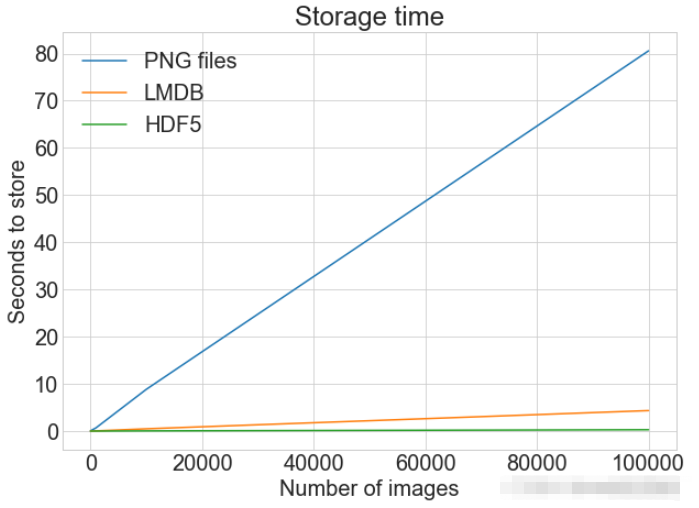
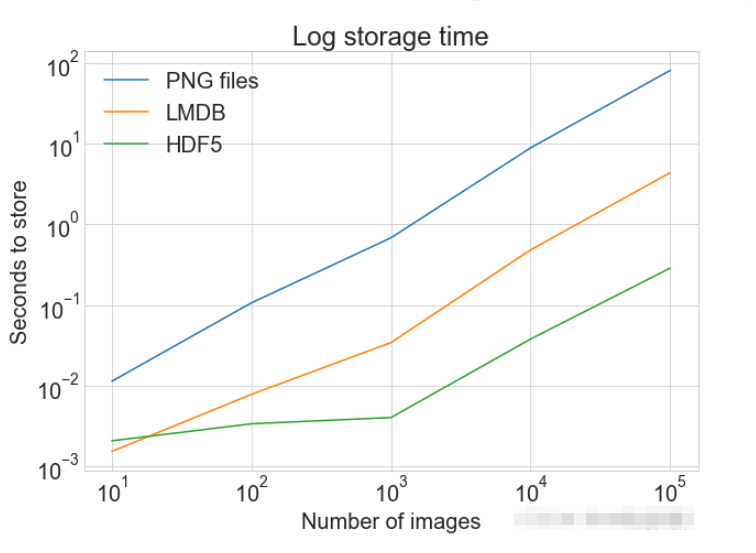
def read_single_disk(image_id):
""" 參數:
---------------
image_id 圖像的整數唯一 ID
返回結果:
---------------
images 圖像數組 (N, 32, 32, 3) 格式
labels 標簽數組 (N,1) 格式
"""
image = np.array(Image.open(disk_dir / f"{image_id}.png"))
with open(disk_dir / f"{image_id}.csv", "r") as csvfile:
reader = csv.reader(
csvfile, delimiter=" ", quotechar="|", quoting=csv.QUOTE_MINIMAL
)
label = int(next(reader)[0])
return image, labeldef read_single_lmdb(image_id):
""" 參數:
---------------
image_id 圖像的整數唯一 ID
返回結果:
---------------
images 圖像數組 (N, 32, 32, 3) 格式
labels 標簽數組 (N,1) 格式
"""
# 打開 LMDB 環境
env = lmdb.open(str(lmdb_dir / f"single_lmdb"), readonly=True)
# 開始一個新的事務
with env.begin() as txn:
# 進行編碼
data = txn.get(f"{image_id:08}".encode("ascii"))
# 加載的 CIFAR_Image 對象
cifar_image = pickle.loads(data)
# 檢索相關位
image = cifar_image.get_image()
label = cifar_image.label
env.close()
return image, labeldef read_single_hdf5(image_id):
""" 參數:
---------------
image_id 圖像的整數唯一 ID
返回結果:
---------------
images 圖像數組 (N, 32, 32, 3) 格式
labels 標簽數組 (N,1) 格式
"""
# 打開 HDF5 文件
file = h6py.File(hdf5_dir / f"{image_id}.h6", "r+")
image = np.array(file["/image"]).astype("uint8")
label = int(np.array(file["/meta"]).astype("uint8"))
return image, labelfrom timeit import timeit
read_single_timings = dict()
for method in ("disk", "lmdb", "hdf5"):
t = timeit(
"_read_single_funcs[method](0)",
setup="image=images[0]; label=labels[0]",
number=1,
globals=globals(),
)
read_single_timings[method] = t
print(f"讀取方法: {method}, 使用耗時: {t}")| 存儲方法 | 存儲耗時 |
|---|---|
| Disk | 1.7 ms |
| LMDB | 4.4 ms |
| HDF5 | 2.3 ms |
將多個圖像保存為.png文件就可以理解為多次調用 read_single_method() 這樣。但這不適用于 LMDB 或 HDF5,因為每個圖像都有不同的數據庫文件。
從磁盤中讀取多個都圖像
def read_many_disk(num_images):
""" 參數:
---------------
num_images 要讀取的圖像數量
返回結果:
---------------
images 圖像數組 (N, 32, 32, 3) 格式
labels 標簽數組 (N,1) 格式
"""
images, labels = [], []
# 循環遍歷所有ID,一張一張地讀取每張圖片
for image_id in range(num_images):
images.append(np.array(Image.open(disk_dir / f"{image_id}.png")))
with open(disk_dir / f"{num_images}.csv", "r") as csvfile:
reader = csv.reader(
csvfile, delimiter=" ", quotechar="|", quoting=csv.QUOTE_MINIMAL
)
for row in reader:
labels.append(int(row[0]))
return images, labels從LMDB中讀取多個都圖像
def read_many_lmdb(num_images):
""" 參數:
---------------
num_images 要讀取的圖像數量
返回結果:
---------------
images 圖像數組 (N, 32, 32, 3) 格式
labels 標簽數組 (N,1) 格式
"""
images, labels = [], []
env = lmdb.open(str(lmdb_dir / f"{num_images}_lmdb"), readonly=True)
# 開始一個新的事務
with env.begin() as txn:
# 在一個事務中讀取,也可以拆分成多個事務分別讀取
for image_id in range(num_images):
data = txn.get(f"{image_id:08}".encode("ascii"))
# CIFAR_Image 對象,作為值存儲
cifar_image = pickle.loads(data)
# 檢索相關位
images.append(cifar_image.get_image())
labels.append(cifar_image.label)
env.close()
return images, labels從HDF5中讀取多個都圖像
def read_many_hdf5(num_images):
""" 參數:
---------------
num_images 要讀取的圖像數量
返回結果:
---------------
images 圖像數組 (N, 32, 32, 3) 格式
labels 標簽數組 (N,1) 格式
"""
images, labels = [], []
# 打開 HDF5 文件
file = h6py.File(hdf5_dir / f"{num_images}_many.h6", "r+")
images = np.array(file["/images"]).astype("uint8")
labels = np.array(file["/meta"]).astype("uint8")
return images, labels
_read_many_funcs = dict(
disk=read_many_disk, lmdb=read_many_lmdb, hdf5=read_many_hdf5
)創建一個計算方式進行對比
from timeit import timeit
read_many_timings = {"disk": [], "lmdb": [], "hdf5": []}
for cutoff in cutoffs:
for method in ("disk", "lmdb", "hdf5"):
t = timeit(
"_read_many_funcs[method](num_images)",
setup="num_images=cutoff",
number=1,
globals=globals(),
)
read_many_timings[method].append(t)
# Print out the method, cutoff, and elapsed time
print(f"讀取方法: {method}, No. images: {cutoff}, 耗時: {t}")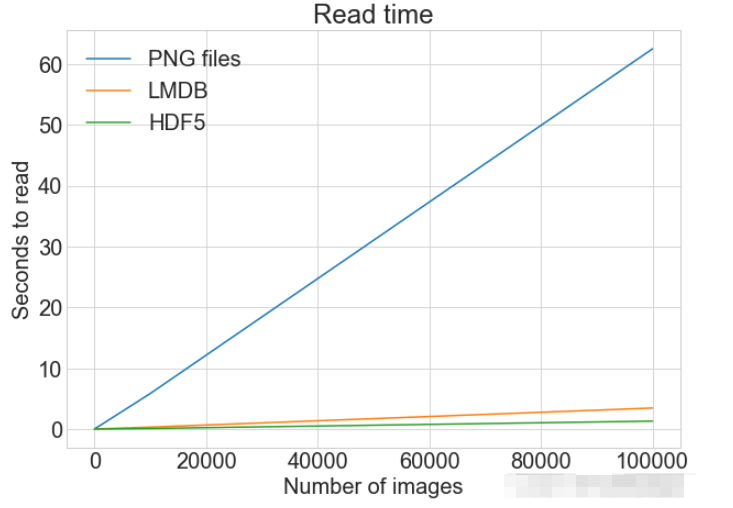
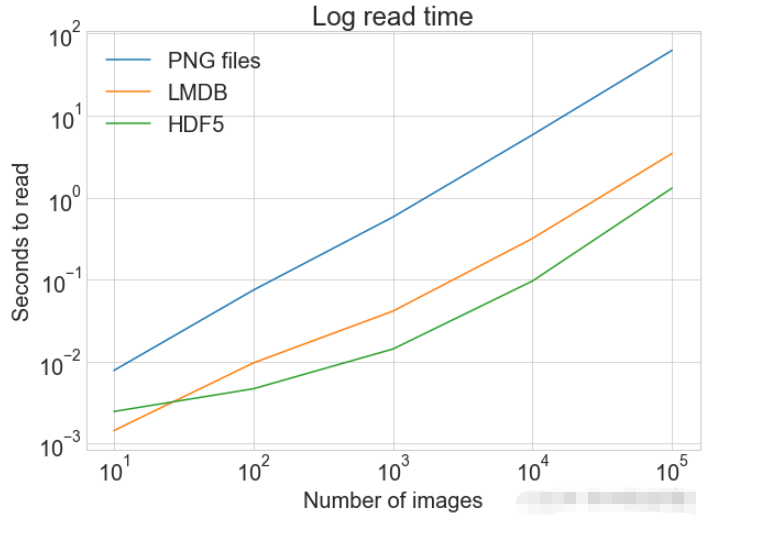
同一張圖表上查看讀取和寫入時間
plot_with_legend( cutoffs, [disk_x_r, lmdb_x_r, hdf5_x_r, disk_x, lmdb_x, hdf5_x], [ "Read PNG", "Read LMDB", "Read HDF5", "Write PNG", "Write LMDB", "Write HDF5", ], "Number of images", "Seconds", "Log Store and Read Times", log=False, )
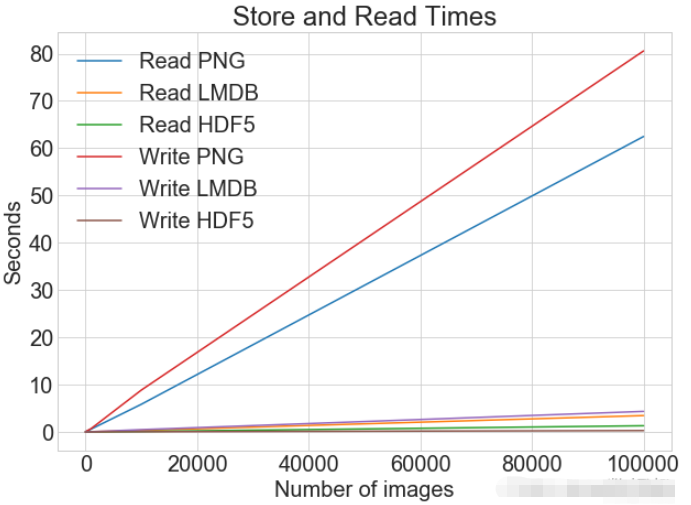
各種存儲方式使用磁盤空間
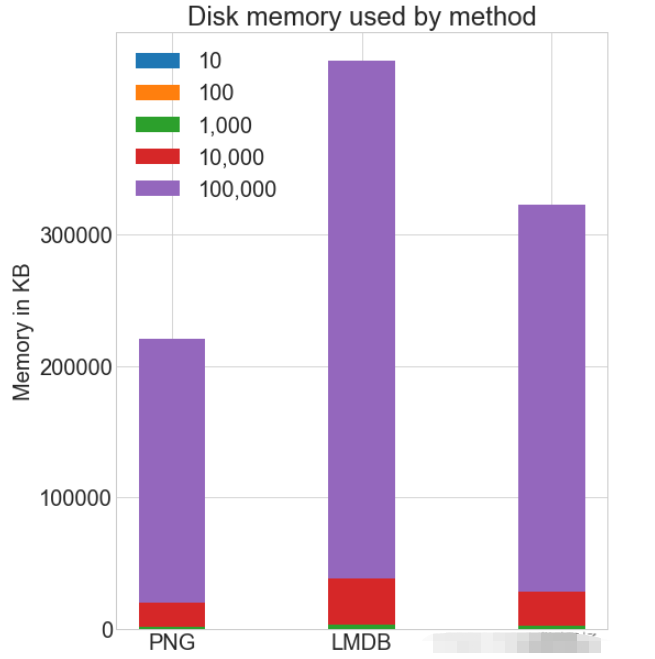
雖然 HDF5 和 LMDB 都占用更多的磁盤空間。需要注意的是 LMDB 和 HDF5 磁盤的使用和性能在很大程度上取決于各種因素,包括操作系統,更重要的是存儲的數據大小。
通常對于大的數據集,可以通過并行化來加速操作。 也就是我們經常說的并發處理。
作為.png 文件存儲到磁盤實際上允許完全并發。只要圖像名稱不同就可以從不同的線程讀取多個圖像,或一次寫入多個文件。
如果將所有 CIFAR 分成十組,那么可以為一組中的每個讀取設置十個進程,并且相應的處理時間可以減少到原來的10%左右。
以上就是“Python圖片存儲和訪問的三種方式是什么”這篇文章的所有內容,感謝各位的閱讀!相信大家閱讀完這篇文章都有很大的收獲,小編每天都會為大家更新不同的知識,如果還想學習更多的知識,請關注億速云行業資訊頻道。
免責聲明:本站發布的內容(圖片、視頻和文字)以原創、轉載和分享為主,文章觀點不代表本網站立場,如果涉及侵權請聯系站長郵箱:is@yisu.com進行舉報,并提供相關證據,一經查實,將立刻刪除涉嫌侵權內容。